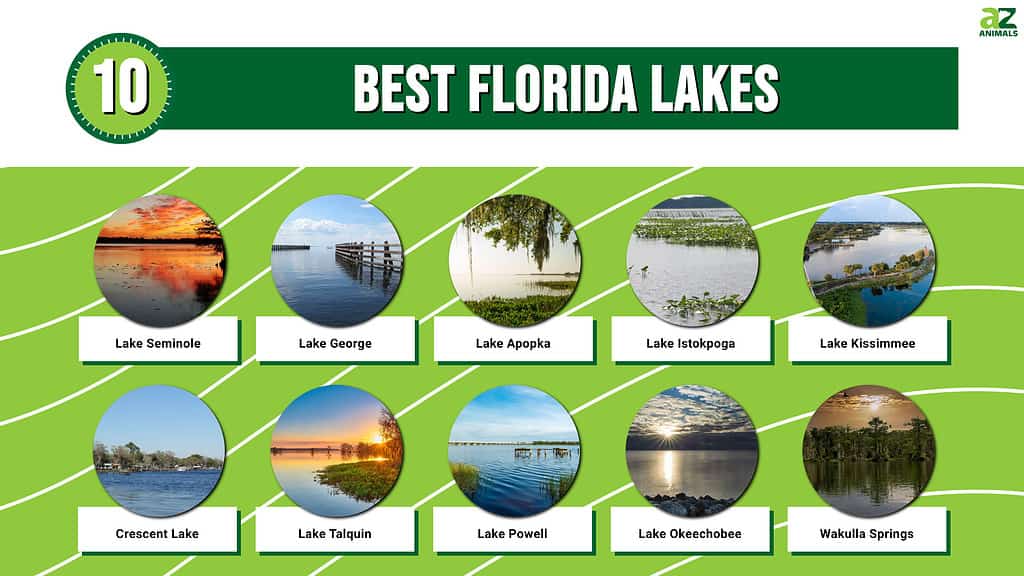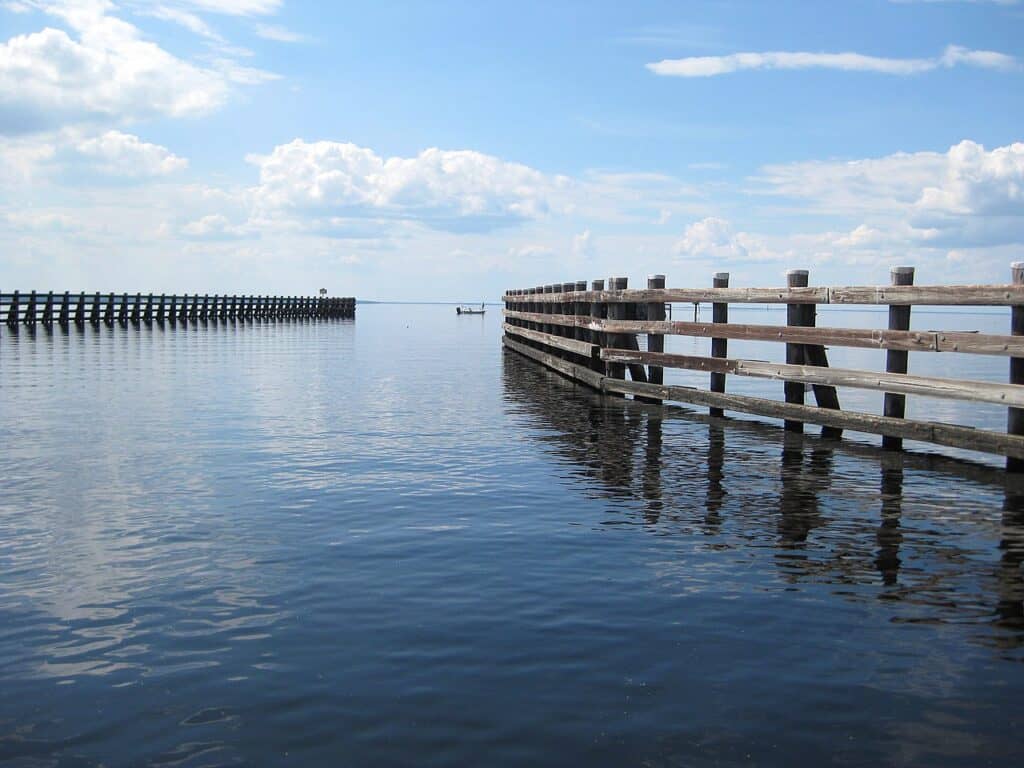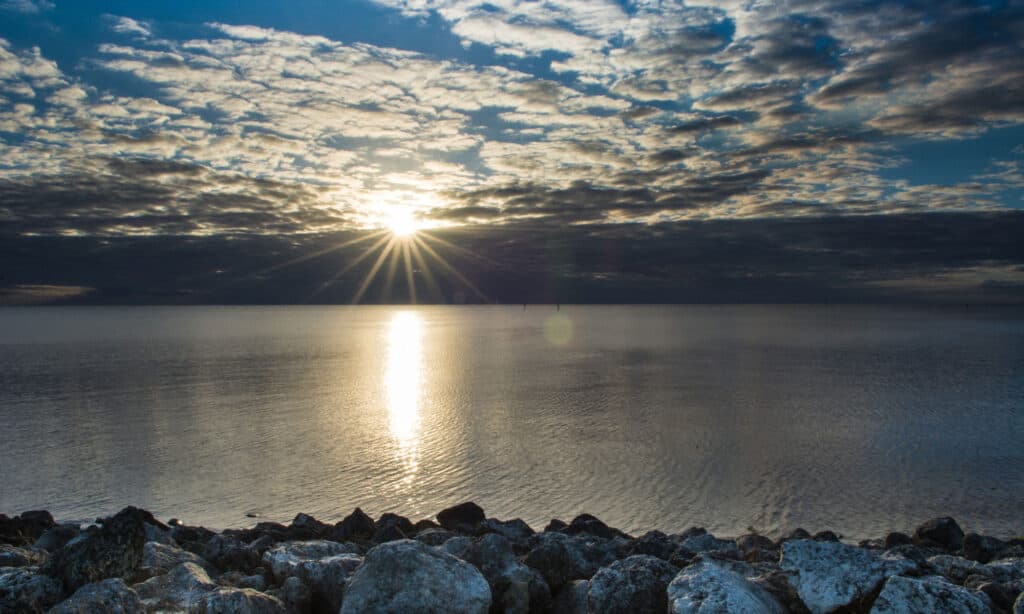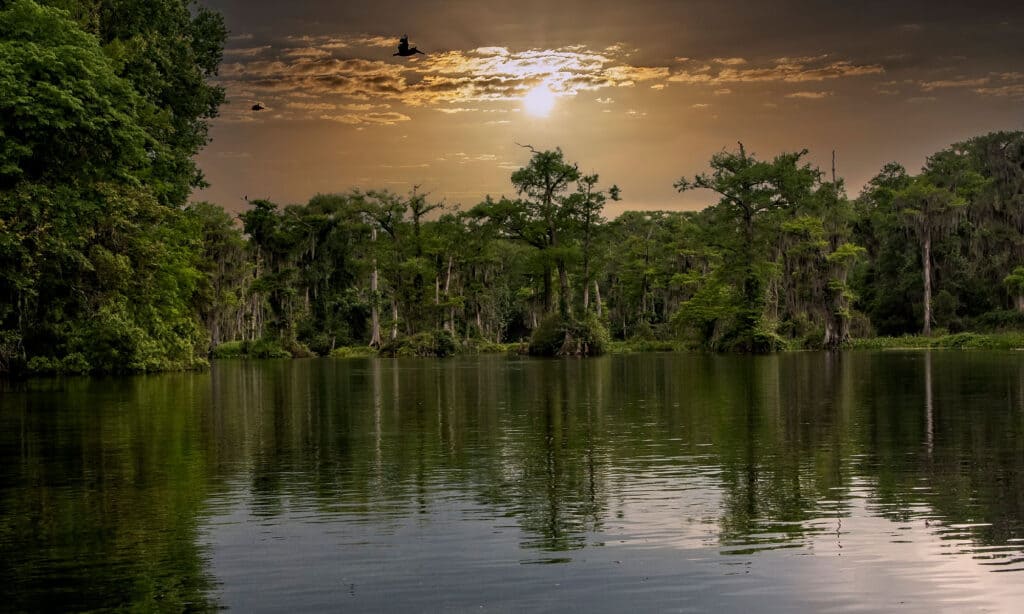The sunshine state is home to a plethora of amazing lakes. Some of the types of lakes in Florida include the deepest freshwater spring in the world, a lake once fished by Al Capone, a couple of the best bass spots in the country, and one area internationally known for birdwatching.
Most of the water systems in the state are home to alligators so swimming is generally not advised. Many of the lakes are also quite shallow so boaters should research ahead of time to ensure their vessel will be permitted. When you do get your boat out on the water be on the lookout for stumps and logs that could cause damage.
One lake in particular really stands out on this list. Lake Powell near Panama City Beach is a truly miraculous sight. I personally have spent a good amount of time there and can highly recommend it. It’s a very unique body of water that makes exchanges with the ocean causing a super unique fishing experience.
Here is a chart to help you get familiar with the 10 Florida lakes we’ll be diving into:

1. Lake Seminole

Named after the Seminole Native Americans, Lake Seminole is a brackish Bassmasters Preferred Lake
©Carolyn Davidson Hicks/Shutterstock.com
- Surface Area: 37,561 acres
- Max Depth: 30 Feet
- Camping/Overnight Available: Yes
- Boating/Docks Available: Yes
- Swimming Permitted: No
- Fishing Permitted: Yes
- Best For: Bass Fishing, Bassmasters Preferred Lake
Lake Seminole was once the land of Seminole Native Americans who inhabited the area thousands of years before. The lake is brackish meaning it was both salt and fresh water in it. The lake is an angler’s paradise containing over forty-six species of fish.
The popular fish species to fish for are largemouth bass, crappie, catfish, chain pickerel, and striped bass. The lake has a pier available to fish from and seventeen ramps for boaters. Additional amenities at the lake include picnic tables & shelters, ball courts, playgrounds, and miniature golf.
Lake Seminole Park has a two-mile hiking trail with several small ponds along its path. Wildlife enthusiasts and birdwatchers can spot alligators, snakes, frogs, deer, osprey, bald eagles, various duck species, pileated woodpeckers, and red-headed woodpeckers.
2. Lake George

Lake George is the second largest lake in the state of Florida and home to a myriad of wildlife and fish species
©TampAGS, for AGS Media / CC BY-SA 3.0, via Wikimedia Commons – License
- Surface Area: 46,000 acres
- Max Depth: 200 Feet
- Camping/Overnight Available:
- Boating/Docks Available:
- Swimming Permitted: Not Recommend
- Fishing Permitted: Yes
- Best For: Second Largest Lake in Florida, Largemouth & Striped Bass Fishing, Blue Crab Fishery
The shallow, brackish waters of Lake George create a home for a myriad of fish and wildlife species. Camping and boating amenities are abundant across the lake’s fifty miles of shoreline and surrounding areas. The lake has the only freshwater blue crab fisheries in the entire world.
Fishing is diverse with fresh and saltwater species including largemouth bass, striped bass, crappie, bluegill, warmouth, bowfin, chain pickerel, longnose gar, Atlantic stingray, shark, mullet, and shellcracker. There are multiple boat ramps and a pier for fishing.
In addition to the vast array of fish all kinds of wildlife call the lake home. Some of the wildlife seen at Lake George includes herons, egrets, osprey, eagles, alligators, fox squirrels, gopher tortoises, bald eagles, bobcats, hawks, otters, owls, ospreys, wild turkeys, and white-tailed deer. Whatever lake experience you’re looking for is more than likely available at the second largest lake in Florida.
3. Lake Apopka

Lake Apopka, just fifteen miles from Orlando, was once fished by Al Capone!
©iStock.com/Holcy
- Surface Area: 30,803 acres
- Max Depth: 18 Feet
- Camping/Overnight Available: Yes
- Boating/Docks Available: Yes
- Swimming Permitted: Not Recommended
- Fishing Permitted: Yes
- Best For: Fourth Largest Lake in Florida, Bass Fishing Tournaments
Al Capone and Clark Gable once fished the waters of Lake Apopka. It was at one time a bass capital of the Eastern United States. Lake Apopka is fifteen miles from Orlando. Water from the lake flows into several others forming a chain of lakes.
Lake Apopka is a shallow body of water with many alligators and stumps. Boaters should use caution and avoid going too quickly on the lake. Four boat ramps are available, mostly for smaller vessels due to the shallow water.
Fish species at Lake Apopka include catfish, crappie, sunfish, pickerel, and sunshine bass. In addition to fishing, wildlife and bird viewing are exceptional at the lake. Just a few of the birds you can find include mourning dove, common gallinule, anhinga, great egret, turkey vulture, Cooper’s hawk, great horned owl, and downy woodpecker.
4. Lake Istokpoga

The fifth Largest Lake in Florida, Lake Isotokpoga, is home to an array of fish and wildlife species
©iStock.com/Warren-Pender
- Surface Area: 27,692 acres
- Max Depth: 10 Feet
- Camping/Overnight Available: Yes
- Boating/Docks Available: Yes
- Swimming Permitted: Not Recommended
- Fishing Permitted: Yes
- Best For: Fifth Largest Lake in Florida, Great Bass & Crappie Fishing
Lake Istokpoga is located in the town of Lake Placid, Florida. It’s known for great bass and crappie fishing. Visitors may wish to catch an airboat to view the vast expanses of the water.
Other fish caught regularly at Lake Istokpoga include speck, bream, crappie, and pickerel. The best time to fish in the lake is said to be in the winter. There are multiple boat ramps available at Lake Istokpoga.
The lake also offers a dense variety of birds and wildlife. A few of the birds you might see include egrets, owls, herons, turkeys, ducks, bald eagles, osprey, and buzzards. In addition to the birds, it’s quite likely to spot squirrels, wild hogs, and alligators to name a few.
5. Lake Kissimmee

Lake Kissimmee is internationally known for birdwatching and its trophy-winning, monster bass!
©iStock.com/Juliana Vilas Boas
- Surface Area: 34,950 acres
- Max Depth: 12 Feet
- Camping/Overnight Available: Yes
- Boating/Docks Available: Yes
- Swimming Permitted: Not Recommended
- Fishing Permitted: Yes
- Best For: Internationally Known for Birdwatching, Monster Bass, Most Remote Florida Lake, Cowboy Culture/History
Lake Kissimmee is an absolutely amazing body of water with gigantic bass and is internationally known for its bird watching and wildlife viewing. There are five islands in the lake, Brahma Island, Sturm Island, Bird Island, Rabbit Island, and Ox Island.
In addition to the mammoth-sized bass, anglers can expect to catch crappie, bluegill, sunfish, gar, pickerel, and big channel catfish. The lake and surrounding area are also home to many different animals and birds.
Birdwatchers and wildlife enthusiasts can take advantage of the opportunity to view bald eagles, black vultures, shorebirds, white-tailed deer, ospreys, bobcats, turkeys, whooping cranes, and sandhill cranes. There are twenty miles of hiking and equestrian trails to explore and enjoy.
For camping one option is Lake Kissimmee State Park Campground, it’s been called one of the best campgrounds in the state. There are actually sixty campsites available providing a wide range of camping experiences.
6. Crescent Lake

Anglers fish for a wide range of species at Crescent Lake wondering where the mysterious sunken Alligator steamboat might rest
©FloNight (Sydney Poore) and Russell Poore / Creative Commons – License
- Surface Area: 15,960 acres
- Max Depth: 10 Feet
- Camping/Overnight Available: Yes
- Boating/Docks Available: Yes
- Swimming Permitted: Not Recommended
- Fishing Permitted: Yes
- Best For: Beautiful Scenery, Clean Water, Excellent Bass Fishing, Alligator Steamboat History
According to historical records, there is a sunken steamboat on the bottom of Crescent Lake. The Alligator steamboat caught fire and sunk into the lake’s waters in the early nineteen hundreds. There were no injuries as the incident happened at night with no passengers aboard.
Crescent Lake provides spectacular fishing. There are many different types of fish that swim in the lake including shellcracker, largemouth bass, channel catfish, white catfish, black crappie, bluegill, redear sunfish, spotted sunfish, warmouth, striped bass, hybrid striped bass, chain pickerel, and longnose gar.
The lake is great for fishing due to the wide range of habitats available. The different environments include shallow grasses, shell beds, sharp drop-offs, ledges, lily pad fields, logs and cypress trees, creek channels, canals, and boat docks. Crescent Lake has areas with high enough salinity levels to support a small blue crab fishery.
7. Lake Talquin

lake Talquin offers a relaxed, undeveloped experience and is known for superior black bass and crappie fishing
©iStock.com/Patrick Jennings
- Surface Area: 10,800 acres
- Max Depth: 40 Feet
- Camping/Overnight Available: Yes
- Boating/Docks Available: Yes
- Swimming Permitted: Not Recommended
- Fishing Permitted: Yes
- Best For: Undeveloped, Black Bass & Crappie Fishing
Lake Talquin is a more undeveloped body of water than some of the others in Florida. The lake is a little over ten miles from Tallahassee, making it an excellent weekend getaway. Winter fishing for black crappie and black bass is what the lake is known best for by many anglers.
Many small fish inhabit the lake providing food for an abundance of larger species. Some of the smaller baitfish include golden shiner, Seminole killfish, sunfish, crayfish, threadfin shad, and gizzard shad. The feeds the abundance of white bass, black bass, striped bass, black crappie, bluegill, bream, pickerel (“jack”), gar, catfish, bowfin, and redear sunfish.
Talquin Lake and the forest around it are home to an extensive collection of wildlife species. You can find all sorts of creatures and critters running around including white-tail deer, turkeys, bald eagles, water turtles, eastern gray squirrels, fox squirrels, ospreys, egrets, blue herons, water snakes, alligators, and over a hundred species of birds.
8. Lake Powell

Lake Powell and connecting Philips Inlet are the largest coastal dune lake in North America
©iStock.com/RAUL RODRIGUEZ
- Surface Area: 161,390 acres
- Max Depth: 583 Feet
- Camping/Overnight Available: Yes
- Boating/Docks Available: Yes
- Swimming Permitted: Not Recommended
- Fishing Permitted: Yes
- Best For: Paranormal Enthusiasts, Largest Coastal Dune Lake in North America
Lake Powell is a majestic and unique lake that connects to the ocean making it a brackish body of water. This enables a host of different fish and animals to inhabit the area. The white-sanded coastal dunes at Lake Powell are surreal in their beauty.
The unique ecosystem at Lake Powell provides a home to fresh and saltwater fish including catfish, striped bass, largemouth bass, flounder, mullet, oysters, redfish, speckled trout, pompano, sheepshead, ladyfish, bluefish, flounder, red drum, and black drum. Blue crab is also present in the lake and a whale shark was even spotted once in Philips Inlet!
If you’re into ghost stories and the paranormal nearby Camp Helen State Park doesn’t disappoint. There is not one, but three reported ghosts roaming in the area of Lake Powell. Anglers report seeing one of the ghosts sitting upon docks to this day.
9. Lake Okeechobee

Lake Okeechobee is a premier fishing destination with full-service lake amenities with a haunted history
©Allison Michael/Shutterstock.com
- Surface Area: 450,000 acres
- Max Depth: 12 Feet
- Camping/Overnight Available:
- Boating/Docks Available:
- Swimming Permitted: Not Recommended
- Fishing Permitted: Yes
- Best For: Paranormal Enthusiasts, Limestone Basin, Florida’s Inland Sea, Best Freshwater Fishing in Florida
Lake Okeechobee is the largest freshwater lake in Florida. The lake is known to be the best fishing lake in the entire state. Anglers are keen on hooking any of the fish in the lake including speckled perch, black crappie, bluegill, butterfly peacock bass, white bass, sunshine bass, spotted bass, black bass, shoal bass, and striped bass. Baits said to work well in the lake are worms, crayfish, and insects.
For paranormal enthusiasts, Lake Okeechobee offers a different draw than anglers. There is a history of a town under the water and some other pretty interesting paranormal activity at the lake. Visitors can listen to a podcast to learn more about the lake’s haunted history.
Along the one hundred and ten-mile Lake Okeechobee Scenic Trail visitors can spot one of many wildlife species that inhabit the area. Some of the animals and birds you might encounter include wild hogs, manatees, turkey, Everglade snail kites, wading birds, purple gallinules, frogs, snakes, turtles, seagulls, hawks, loons, and blue herons.
10. Wakulla Springs

Wakulla Springs in Edward Ball Wakulla Springs State Park is the deepest freshwater spring in the world
©iStock.com/Ruth Peterkin
- Surface Area: N/A
- Max Depth: N/A
- Camping/Overnight Available: No (Nearby Hotel/Lodge)
- Boating/Docks Available: No
- Swimming Permitted: Yes
- Fishing Permitted: No
- Best For: Tallahassee’s Hidden Gem, World’s Deepest Freshwater Spring
Edward Ball Wakulla Springs State Park is a six thousand acre wildlife sanctuary. It’s home to Wakulla Springs the deepest freshwater spring in the world. Wakulla Springs is an amazing and unique swamp environment with alligators, manatees, birds, snakes, frogs, and all sorts of other creatures.
The springs were originally found through the discovery of an ancient mastodon laying in the bottom of the water. Wakulla Springs is a vast ecosystem today providing a home to a wide range of wildlife. Some of the different birds and animals include West Indian manatees, white-tailed deer, North American river otters, American alligators, Suwannee River cooters (pseudemys suwanniensis), snapping turtles, softshell turtles, limpkin, purple gallinules, herons, egrets, bald eagles, anhingas, ospreys, common moorhens, wood ducks, black vultures, and turkey vultures.
In addition to the amazing wildlife at Wakulla Springs, it’s been the site of several movies. Some of the first Tarzan films were shot in the areas around Wakulla Springs. If all that wasn’t enough, you can also take a glass-bottom boat tour through the water!
Summary Table for the 10 Best Lakes in Florida!
| Lake | Type of Water | Feature |
|---|---|---|
| Lake Seminole | Brackish | Hiking Trail, Bassmasters Preferred Lake |
| Lake George | Brackish | Only freshwater blue crab fishery in world |
| Lake Apopka | Freshwater | Near Orlando, bass fishing tournaments and good birdwatching |
| Lake Istokpoga | Freshwater | Near Lake Placid |
| Lake Kissimmee | Freshwater | Famous birdwatching, gigantic bass, 5 islands, Lake Kissimmee State Park |
| Crescent Lake | Freshwater with some Salinity | Sunken steamboat, blue crab fishery |
| Lake Talquin | Freshwater | Undeveloped, near Tallahassee |
| Lake Powell | Brackish | White sand coastal dunes, Camp Helen State Park, ghosts! |
| Lake Okeechobee | Freshwater | Underwater town and paranormal activity! |
| Wahally Springs | Freshwater | Wildlife sanctuary, deepest freshwater spring in world |
The photo featured at the top of this post is © iStock.com/Ruth Peterkin
Thank you for reading! Have some feedback for us? Contact the AZ Animals editorial team.






